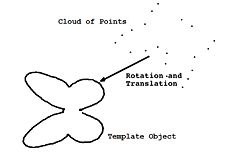| Line 2: | Line 2: | ||
'''Motivation''' | '''Motivation''' | ||
| − | + | <div style='width: 70%; float: left;'> | |
| − | Consider the problem of curve registration, that is, finding the rotation and translation that best maps (i.e., registers) a cloud of points onto a template object, as described | + | Consider the problem of curve registration, that is, finding the rotation and translation that best maps (i.e., registers) a cloud of points onto a template object, as described on the right. |
We begin by approximating the curve defined by the contour of the template object by an implicit polynomial equation. This yields a bivariate | We begin by approximating the curve defined by the contour of the template object by an implicit polynomial equation. This yields a bivariate | ||
polynomial equation p(x,y) = 0 whose solution set approximates the template | polynomial equation p(x,y) = 0 whose solution set approximates the template | ||
contour. | contour. | ||
| + | </div> | ||
| + | <div style='width: 30%; float: right;'> | ||
| + | [[Image:butterfly model.jpg|250px]] | ||
| + | </div> | ||
| + | <div style='width: 100%; float: left;'> | ||
Revision as of 16:50, 21 April 2010
A Solution Method For Zero-Dimensional Polynomial Equation System
Motivation
Consider the problem of curve registration, that is, finding the rotation and translation that best maps (i.e., registers) a cloud of points onto a template object, as described on the right.
We begin by approximating the curve defined by the contour of the template object by an implicit polynomial equation. This yields a bivariate polynomial equation p(x,y) = 0 whose solution set approximates the template contour.


